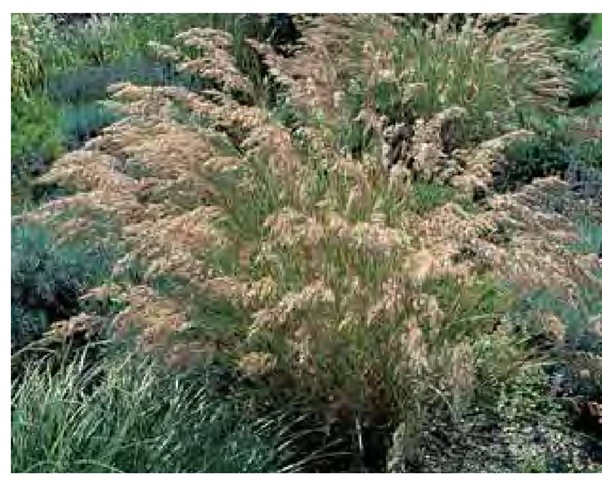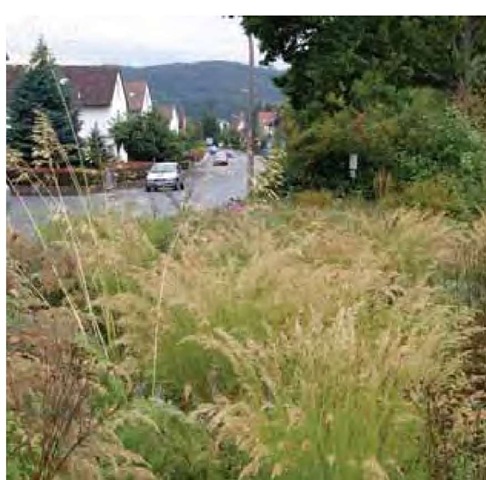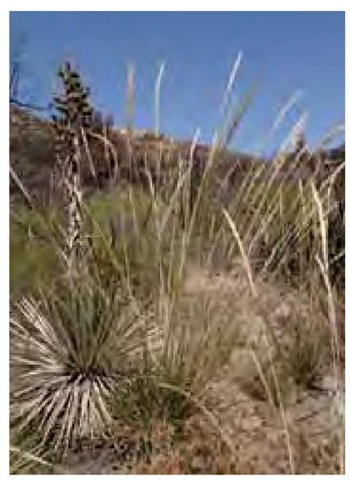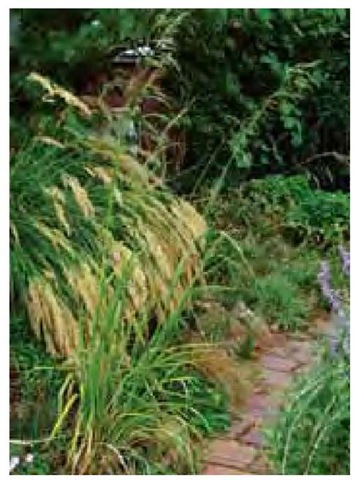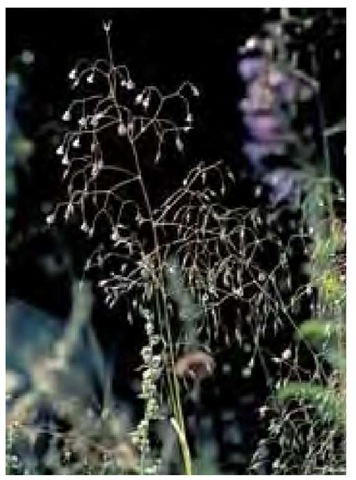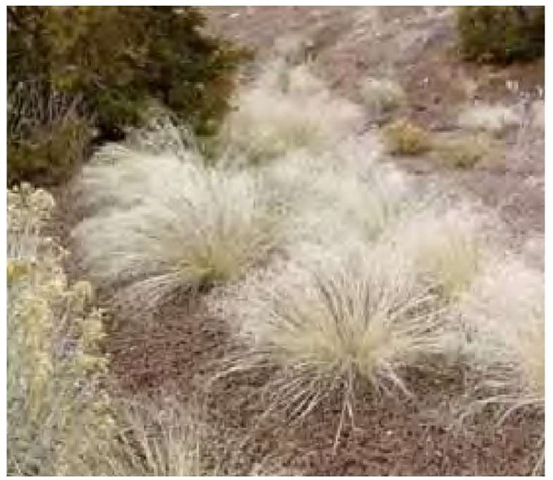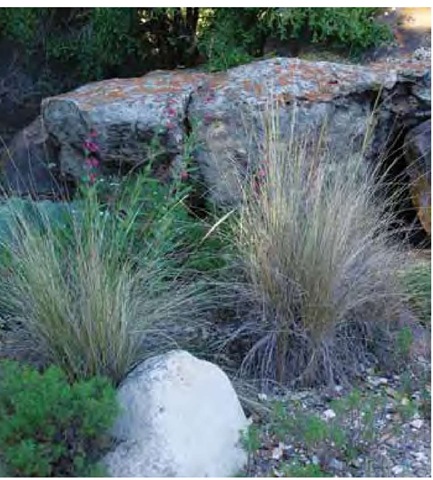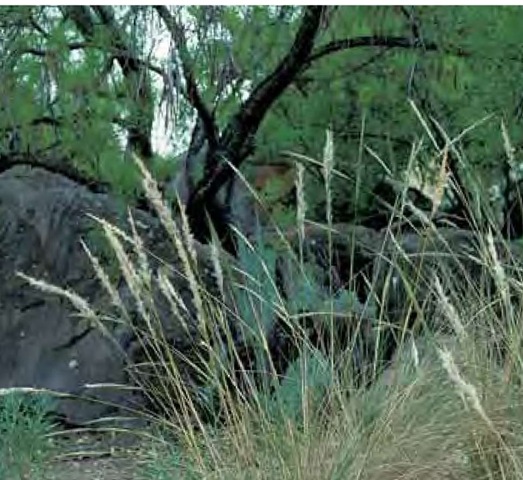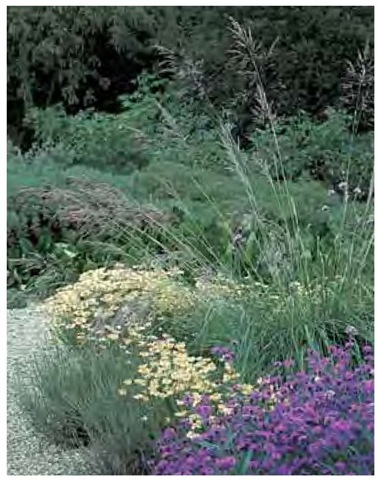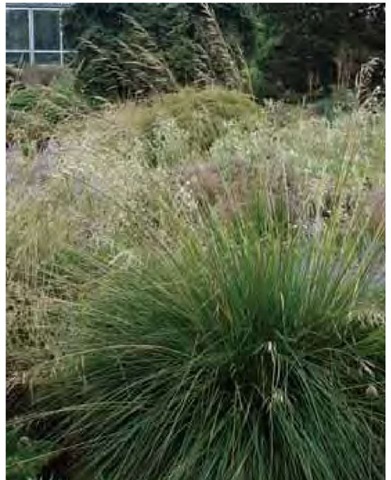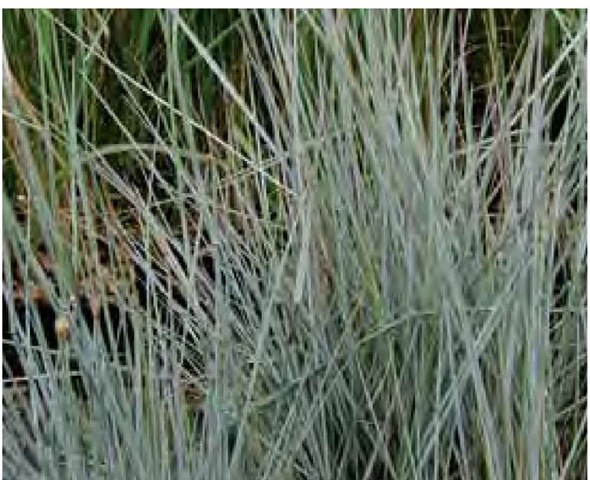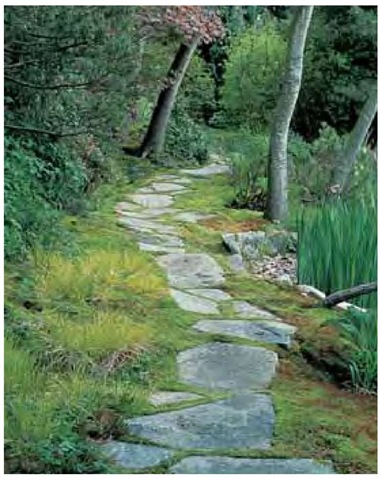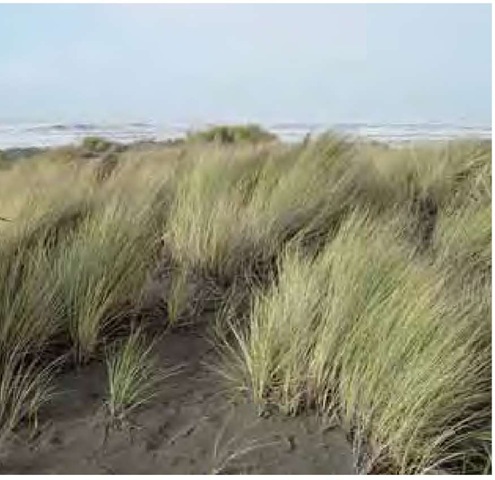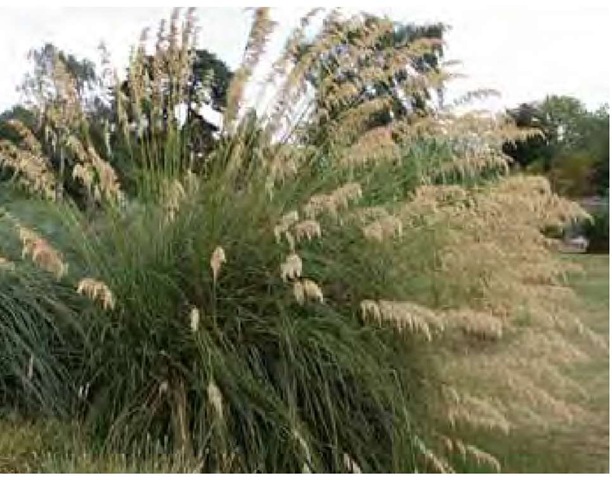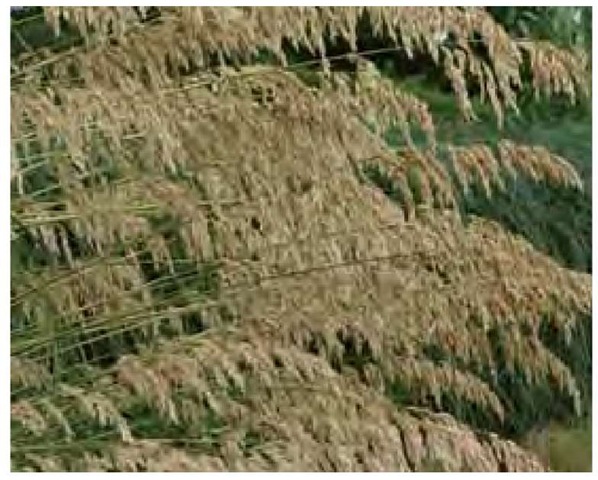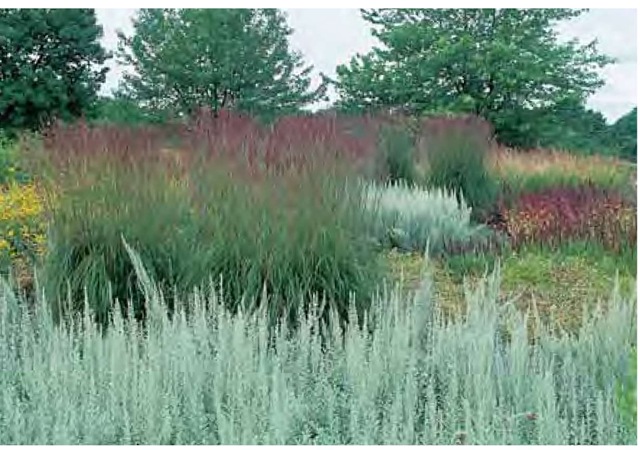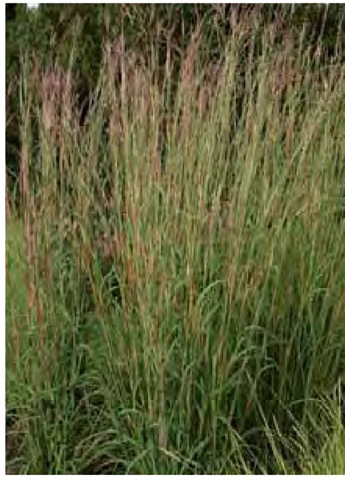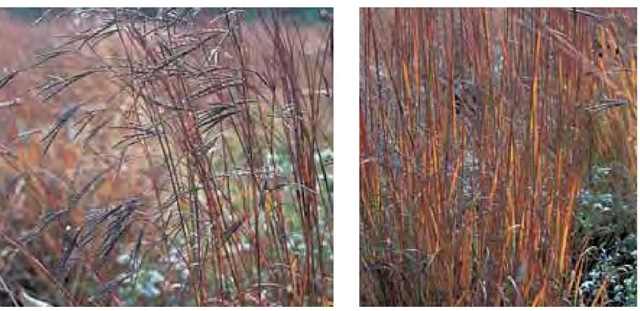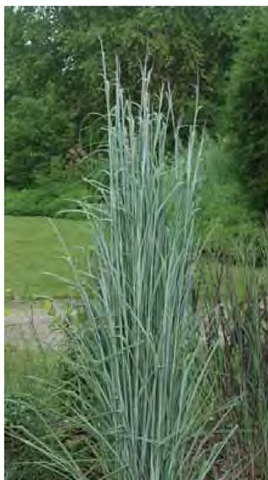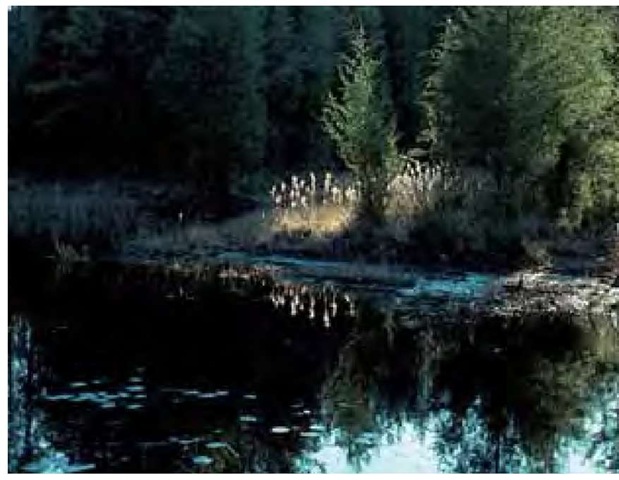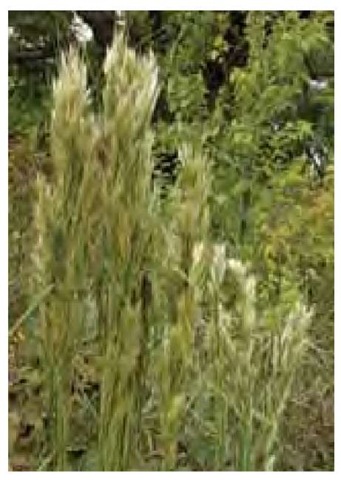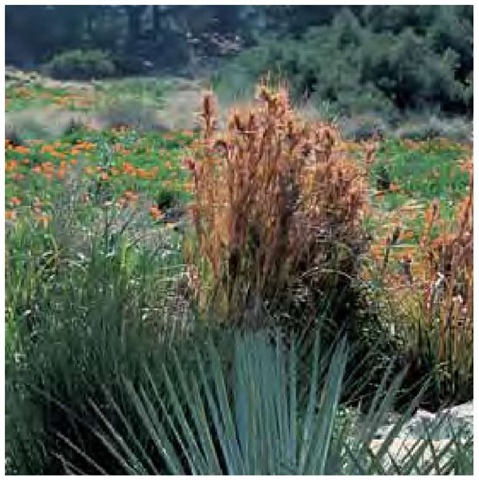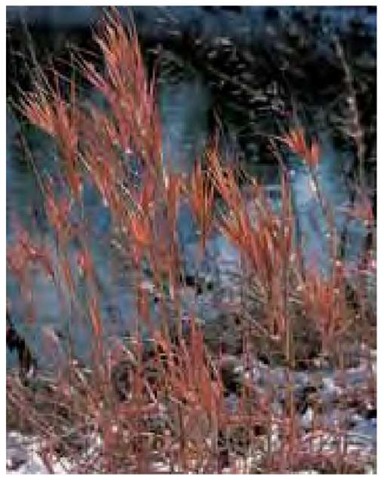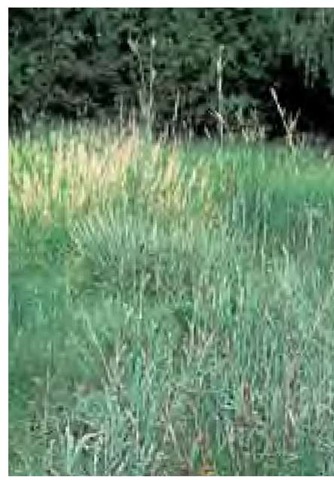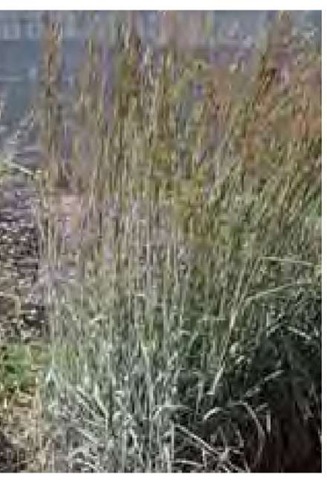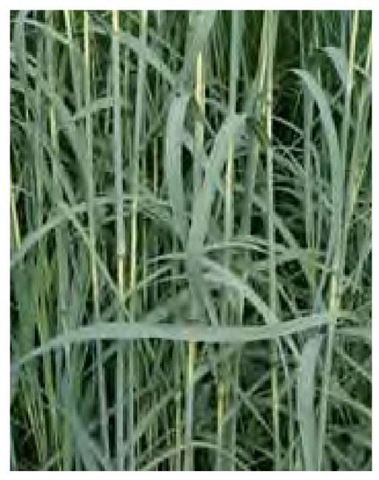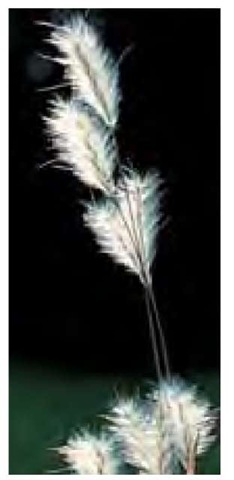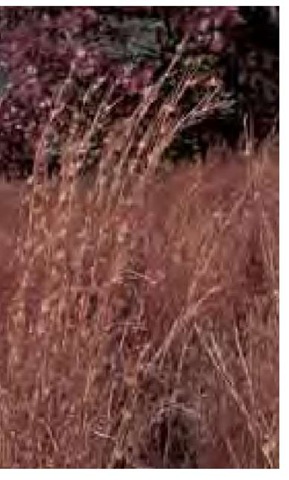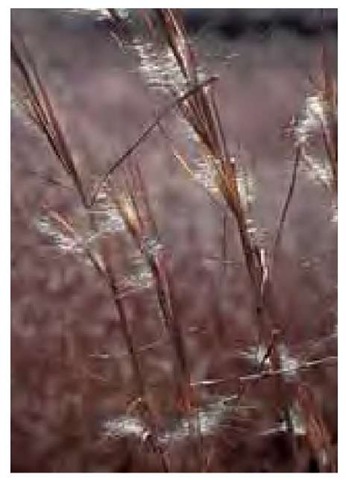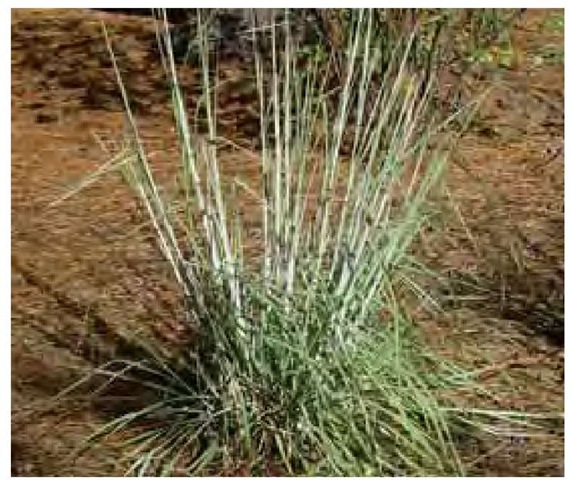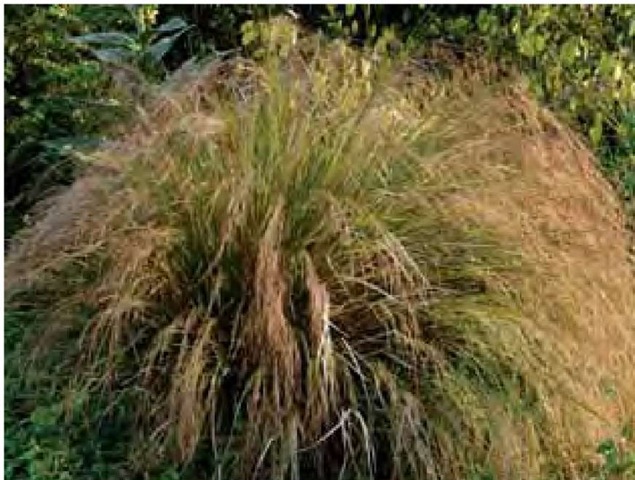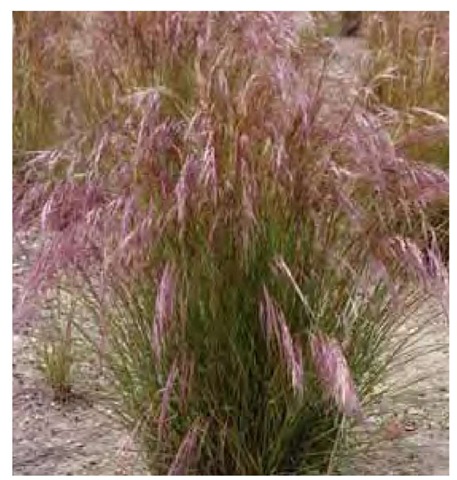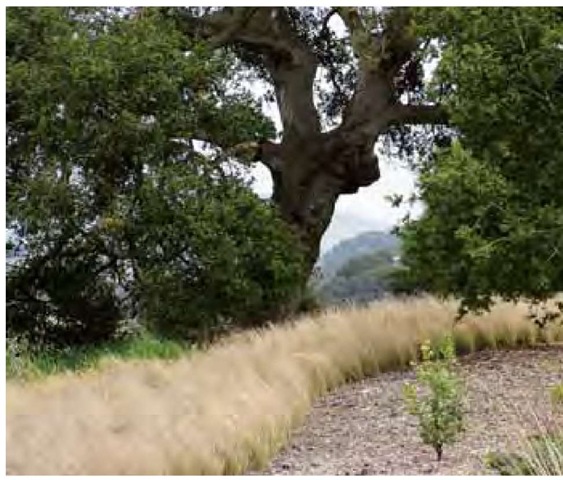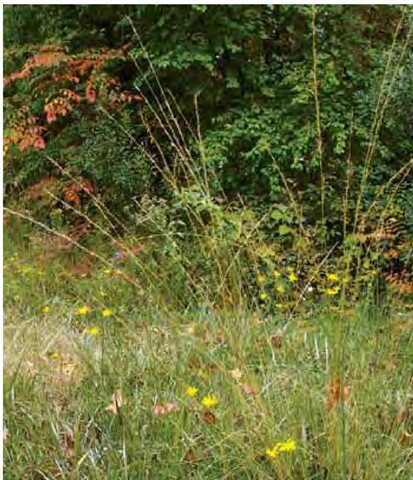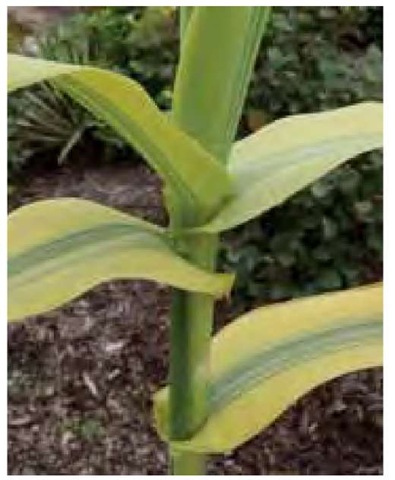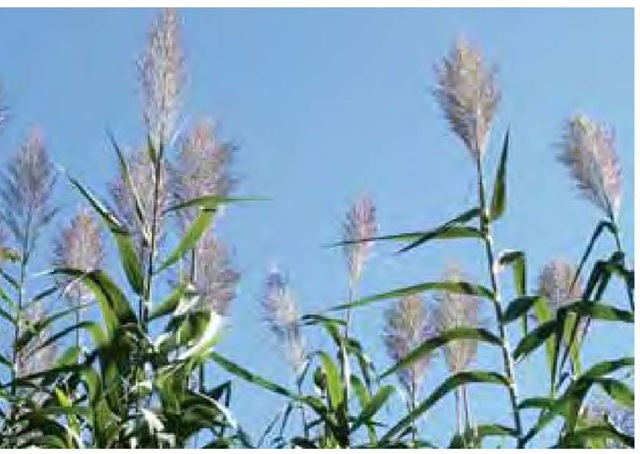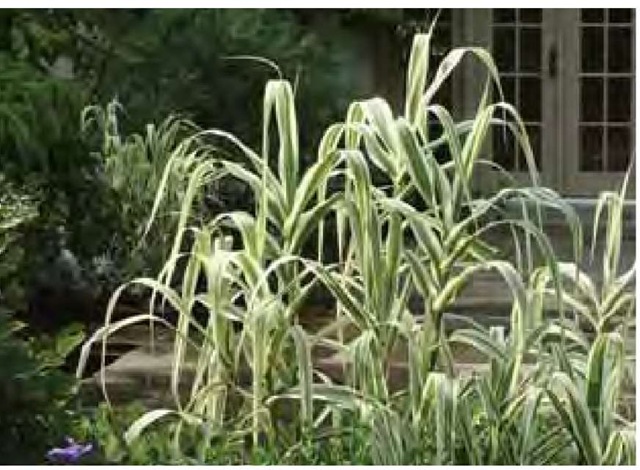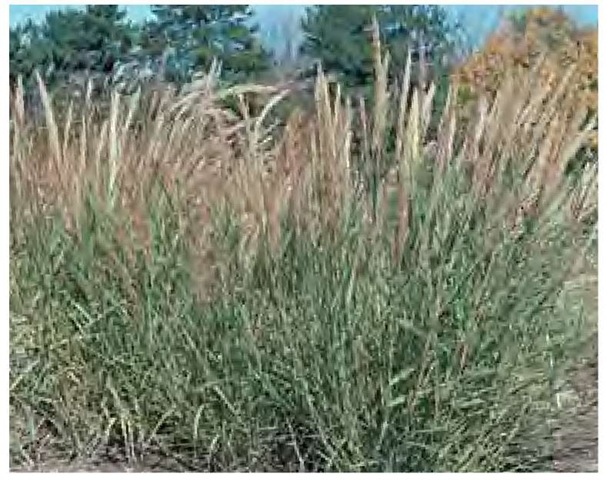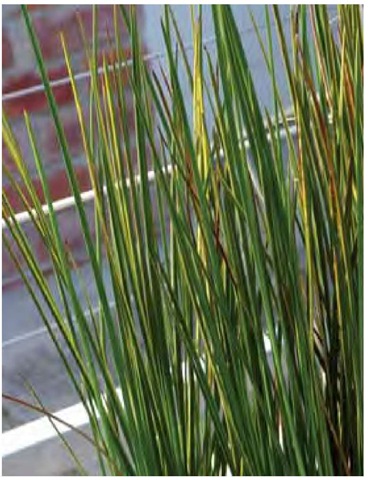ENTRIES FOR INDIVIDUAL GENERA and species are in alphabetical order by botanical name, followed immediately by the author citation (s). Genus entries begin with the common and botanical names of the corresponding plant family, followed by the common name(s) of the genus, if any, followed by the description. Species entries begin with the accepted botanical name and author citation(s) followed by synonyms, if any, in brackets [ ], followed by the common name. Multiple common names are in order of popular North American usage. If a genus or species appears to be missing, the name may have been changed. Use the index to find a cross-reference to the accepted name. Cultivar names are in bolder type enclosed by single quotation marks. Synonyms for cultivars, if any, follow the accepted name and are enclosed in single quotes in parentheses. Transliterations of vernacular cultivar names are also enclosed in parentheses but not in single quotes. All cultivars should be assumed to require vegetative propagation unless noted. Hardiness zones listed for species refer to the USDA and European hardiness zone maps reproduced at the back of this topic. Hardiness of cultivars is the same as the species unless specifically noted.
Achnatherum p. Beauvois Grass family, Poaceae Needle grass, spike grass Densely tufted, clump-forming species from central and southern Europe, eastern Asia, and western North America, the majority split from the genus Stipa. The common names refer to the presence of numerous needlelike awns on the florets, a characteristic Achnatherum shares with Stipa, and one which contributes to the feathery, luminescent qualities of the inflorescences. All are cool-season growers, freely flowering from early spring into summer in regions with strong sun but cool nights and low humidity. The dry inflorescences are persistent and often remain attractive for months.
Achnatherum calamagrostis (Linnaeus) P. Beauvois [Stipa calamagrostis (Linnaeus) Wahlenberg] Silver spike grass, silver spear grass Native to high-elevation clearings in mountainous regions of central and southern Europe. One of the most graceful, free-flowering mid-sized ornamental grasses if provided plenty of sunlight, low humidity, and cool summer nights. Clump-forming and densely tufted, increasing slowly in girth. Produces a fountain of refined, medium-green foliage topped in June by full but equally fine-textured silver-green inflorescences. Typically 2 to 3 feet (60-90 cm) tall in bloom. The flowers turn beautifully tawny by late July or August and remain attractive entirely through winter in milder climates. The foliage is semievergreen in mild climates and deciduous in cold regions. Prefers full sun. Will grow in light shade although stems will be more lax. Prefers well-drained, average to low-nutrient soils. Growth is weak and floppy in rich soils. It is remarkably drought-tolerant and deserves more attention in Mediterranean and steppe climates. The rounded form and loosely spilling flowering stems evoke cascading water. This grass is effective singly or in drifts and sweeps. Grow from seed, or divide in spring. Zone 5.
‘Allgau’. An early Karl Partsch selection from the Allgau region of southern Germany.
‘Lemperg’. A compact selection by Hans Simon. ‘Zukunftsmusik’ (future music). Karl Partsch’s improvement on ‘Allgau’, selected from plants growing in a rocky gorge exposed to snow melt from the mountains. More tolerant of moist conditions.
Achnatherum coronatum (Thurber) Barkworth[Stipa coronata Thurber] Giant needle grass Occurs naturally in full sun on dry, gravelly, rocky, often sloping ground in chaparral at elevations up to 5000 feet (1500 m) in southwestern California and adjacent Mexico. Flowers in spring on strictly upright culms 3 to 6 feet (90180 cm) tall. The seedheads remain upright and standing for months. Tufted, with leaves mostly basal. Attractive and well suited to sunny, dry sites. Propagate by seed. Zone 7.
Silver spike grass, Achnatherum calamagrostis, in late August at the Westpark in Munich, Germany
Light rain falls in late August on a drift of Achnatherum calamagrostis ‘Lemperg’ in this community park planting by Hans Simon in Marktheidenfeld, Germany.
Achnatherum extremiorientale (Hara) Keng[Achnatherum pekinense (Hance) Ohwi, Stipa extremiorientalisHara, S. sibirica (Linnaeus) Lamarck] Eastern needle grass This native of Japan, China, Korea, and Siberia is not a desert species. It grows to 5 feet (1.5 m) tall at the edges of woods and grassy slopes in mountains, flowering in mid to late summer. It is a slight, airy plant, with open inflorescences. Leaves deep green, to % inch (15 mm) wide. Grows best in fertile soils with regular moisture, in sun or light shade. Propagate by seed or division. Zone 5.
Achnatherum hymenoides (Roemer & Schultes) Barkworth [Oryzopsis hymenoides. Indian rice grass, sand grass, silky grass This widespread western North American species occurs on well-drained or sandy soils in desert shrublands, sagebrush, and pinyon/juniper woodlands from British Columbia and the Great Plains region south to Texas and west to northern Mexico. Rice grass was an important food grain for southwest North American Indian tribes prior to their cultivation of corn. This delicate, airy grass has suffered from severe habitat destruction due to overgrazing, since it is extremely palatable to livestock. Fine-textured and up to 2 feet (60 cm) tall, Indian rice grass is a cool-season grower, producing attractive, open flower panicles in early spring and going dormant for summer. Grows well in extremely dry situations and will succumb to excess moisture. The delicate seedheads persist though winter and move readily in the wind. Propagate by seed. Zone 5.
Its seeds maturing in early July, giant needle grass, Achnatherum coronatum, grows with Yucca whipplei at the edge of a burned area in Cleveland National Forest in Southern California
Eastern needle grass, Achnatherum extremiorientale, blooms in August in Herman Mussel's garden in Heigenhausen, Germany, with A. calamagrostis (in background).
The Southern California sun illuminates dry seedheads of Indian rice grass, Achnatherum hymenoides, in mid June.
Indian rice grass, Achna-therum hymenoides, in northern New Mexico in late February.
Achnatherum robustum (Vasey) Barkworth [Stipa robusta (Vasey) Scribner] Sleepy grass
Native to dry plains, hills, and open woods from South Dakota and Wyoming south to Texas, Arizona, and northern Mexico, this drought-tolerant species is upright to 5 feet (1.5 m) tall, flowering after winter rains. The common name refers to the effect on grazing livestock, especially horses. Readily grown from seed. Zone 4.
Achnatherum speciosum (Trinius & Ruprecht) Barkworth [Stipa speciosa Trinius & Ruprecht] Desert needle grass Native to desert communities from California to Colorado south to Mexico and South America, this long-lived, exceptionally drought-tolerant grass can survive on only 5 to 10 inches (13-25 cm) annual rainfall. The extremely fine, gray-green foliage forms a rounded basal tuft that turns to rich tans and light browns with summer drought, remaining attractive through winter. Blooms in spring following rains, and flowers remain fluffy into summer. A naturally fine companion to bold-textured cacti and other desert, succulent species. Propagate by seed. Zone 5.
Achnatherum splendens (Trinius) Nevski [Stipa splendens Trinius, Lasiagrostis splendens (Trinius) Kunth] Chee grass
Native to steppes and semidesert sands, gravels, stony slopes, and alkaline areas in central Asia and Siberia, sometimes forming the basis of large vegetation groups known as chee grass associations. This stately grass can reach 8 feet (2.4 m) tall in flower. A June to July bloomer, it produces open, feathery, purplish-pink panicles held high on slender stalks above a large basal mound of green or slightly gray-green narrow foliage. The inflorescences fade to tan color but remain intact and attractive. Prefers full sun, cool night temperatures, and relatively low humidity. As its native habitat suggests, this species can thrive on alkaline or gravelly soils under cultivation. Semievergreen in milder climates. Best propagated by seed. Zone 7.
Desert needle grass, Achnatherum speciosum, in early April at the Santa Barbara Botanic Garden in California.
Desert needle grass, Achnatherum speciosum, in mid June at the Santa Barbara Botanic Garden in California.
Alopecurus Linnaeus
Grass family, Poaceae Foxtail
The genus name is derived from the Greek alopex, fox, and oura, tail, referring to the soft, cylindrical inflorescences. Comprises approximately 36 annual and perennial species native to north-temperate regions and temperate South America. Most are meadow and pasture species of little significance in designed landscapes; however, the following two are valued for their colorful foliage.
Alopecurus borealis Trinius [Alopecurus alpinus Small, non Villars, A. alpinus var. glaucus(Lessing) Krylov, A. glaucus Lessing] Boreal foxtail, alpine foxtail, mountain meadow foxtail, blue foxtail
This very gray-blue grass has a circumpolar distribution in high arctic environments, growing in wet meadows and along streams, lake shores, and river terraces as a primary colonizer of disturbed sites. A cool-season grower, it flowers in late winter or early spring. The flowers, like most meadow foxtails, are insignificant at best. The foliage, up to 8 inches (20 cm) tall, is quite attractive. Mostly clump-forming, spreading very slowly by rhizomes. Does best on low-nutrient soils in cooler climates. The cultivar name ‘Glaucus’ is unnecessary as the typical form of this grass is glaucous. Zone 3.
Flowers of chee grass, Achnatherum splendens, are pink-purple in this mid-July view in Beth Chatto’s gravel garden in Colchester, England.
Past flowering in this late-August view, Achnatherum splendens is still a strong presence at the Berggarten in Hanover, Germany.
Boreal foxtail, Alopecurus borealis, in July in England.
Alopecurus pratensis Linnaeus
Meadow foxtail, common foxtail grass This Eurasian meadow species has naturalized over much of northern North America. It forms dense tufts to 3 feet (90 cm) tall in flower. Mostly clump-forming, spreading very slowly by rhizomes. A cool-season grower, meadow-foxtail is semievergreen in mild, moist temperate climates. The typical form of the species has solid green leaves and is rarely cultivated. Zone 4.
‘Variegatus’ (‘Aureovariegatus’, ‘Aureus’). Golden meadow foxtail, variegated foxtail, gold-variegated foxtail. Among the most colorful of all yellow-leaved grasses. Shorter-growing than the species, with a flowering height of only 18 inches (45 cm). The narrow leaves vary from bright green with vivid yellow longitudinal stripes to nearly solid yellow, producing an overall golden effect, especially when backlit or sidelit. Yellow color is most intense when plants are grown in full sun, although half-shaded plantings will still be a pleasing chartreuse. Flowers appear in late April or May and are insignificant at best. For a neater appearance, it is best to cut plants back to about 5 inches (13 cm) when flowering begins. This helps retain foliage color in summer, when this cool-season grower tends to go lax and semidormant, especially in warm, humid climates. If uncut, the flowers and foliage become unsightly by July or August. Colorful, new growth resumes with the subsiding of summer’s heat, and plants remain attractive until temperatures drop to freezing. A reliable performer of easy culture, tolerant of a wide range of soil types and moisture conditions. Propagate by division in spring or fall.
Ammophila Host
Grass family, Poaceae
Beach grass, dune grass Name derived from the Greek ammos, sand, and philos, loving, referring to the typical habitat. Comprises two north-temperate species, both coarse, strongly rhizomatous warm-season grasses. One is native to coastal Europe and northern Africa, the other to eastern coastal North America. Both are critical, stabilizing elements in the ecologies of coastal dunes. New shoots produced from the rhizomes allow these grasses to survive burial by shifting dune sands. Both species are salt-tolerant. Selected forms are usually propagated by division, and planted 1 foot (30 cm) deep. Neither species withstands regular foot traffic.
Golden meadow foxtail, Alopecurus pratensis ‘Variegatus’, provides color accent along this walk in Terry Welch’s garden in Woodinville, Washington, in mid May
Alopecurus pratensis ‘Variegatus’ in mid May in a full sun setting in Pennsylvania.
Ammophila arenaria (Linnaeus) Link
European dune grass, European beach grass Native to coastal Europe and northern Africa. The species epithet means of the sand. This adaptable, aggressively running species has been planted far beyond its natural range for erosion control in dunes and other sandy soils. Such plantings have displaced American dune grass populations on the West Coast of North America and pingao sedges (Desmoschoe-nus spiralis) that normally occupy the same habitat niche in New Zealand. Although also introduced to the eastern coast of North America, Ammophila arenaria has not proved as persistent there as the local native, A. breviligulata. Zone 5.
Ammophila breviligulata Fernald
American dune grass, American beach grass Native to eastern coastal North America, and essential to the character and ecology of sandy beaches and dunes. It has proved better-adapted in its native region than the introduced European species. Cultivars based on provenance are available for different regions. Most readily established by divisions planted from mid October to mid April, except when ground is frozen. Summer planting is not recommended. Zone 5.
‘Cape’. Selected from a naturally occurring population on Cape Cod, Massachusetts. Best suited for locations from the Mid Atlantic States north to Maine.
‘Hatteras’. Selected for superior performance in warmer, southern coastal locations.
Ampelodesmos Link
Grass family, Poaceae Vine reed
Comprises a single large, tussock-forming species native to coastal areas of northwestern Africa and the Mediterranean Basin eastward to western Greece.
Ampelodesmos mauritanicus (Poiret) T. Durand & Schinz
Vine reed, Mauritania vine reed, rope grass Growing nearly 10 feet (3 m) tall in flower, this majestic tussock-forming grass is on the same scale as the larger pampas grasses, Cortaderia selloana, but unlike pampas grass it is uncommonly cultivated. Vine reed is fire-tolerant and sometimes occurs in large prairielike populations. The generic and common names refer to the early use of this plant to tie grapevines. Flowers are produced from mid to late summer in a great arc above the dark green evergreen basal foliage, remaining attractive through winter. Prefers full sun and well-drained soil. Propagate by seed. This unusual grass has proved durable, drought-tolerant, and noninvasive in English gardens including the Royal Botanic Gardens, Kew, outside London, and Beth Chatto’s gravel garden in Colchester. Zone 8, possibly Zone 7.
European dune grass, Ammophila arenaria, in mid December, planted for stabilization along the northern California coast.
Plantings of American dune grass, Ammophila breviligulata, augment the naturally occurring population along the New Jersey coast, growing with seaside goldenrod, Solidago sempervirens, in mid July.
Andropogon Linnaeus
Grass family, Poaceae Beardgrass
The genus is derived from the Greek aner, man, and pogon, beard, referring to the silky hairs associated with the spike-lets. A large, cosmopolitan genus comprising more than 120 species of annual and mostly perennial grasses of tropical and temperate regions. Many species are from xeric habitats and are tolerant of very dry growing conditions. Approximately 13 species are clump-forming warm-season perennials native to temperate North America, and these are the most commonly cultivated. Most in this group flower in late summer and enliven autumn and winter landscapes with rich, long-lasting orange, red, and copper colors. Some species have glaucous-blue summer foliage, and these often are suffused with red and purple tones in autumn. All are deciduous and are best cut back in late winter or early spring. All species are best propagated by seed, or by division in late winter through spring. This genus is very closely related toSchizachyrium: little bluestem, S. scoparium, was formerly classified as Andropogon scoparius.
Andropogon gerardii Vitman
Big bluestem, turkey foot Occurs naturally in prairies, meadows, sunny riverbanks, and sunlit open woods across much of North America south to central Mexico, often on dry soil. Reaching 5 to 8 feet (1.5-2.4 m) in height, big bluestem is the tallest North American representative of the genus and was once the dominant component of the tallgrass prairie. Prairie ecologist and nurseryman Neil Diboll refers to this regal species as the “monarch of the prairie grasses.” Upright and strictly clump-forming, leaves to 3/8 inch (9 mm) wide, typically green or slightly blue-green in summer, reliably turning rich orange and copper-red in autumn, often with deep burgundy tints with the onset of frosts and freezing temperatures. Three-branched terminal inflorescences that vaguely resemble turkey’s feet appear in late August or early September, opening with noticeably bright red pollen sacs.
The main appeal of this grass is in its lush summer foliage and fall and winter color, which is effective when planted singly or in mass. In the garden, the size and upright stature can be quite dramatic. Ideal for deciduous screening, naturalizing, and for meadow gardens and prairie restorations. Birds and mammals use big bluestem for nesting and cover in summer and winter. Plants that don’t lodge with winter snows also provide spring nesting habitat.
Vine reed, Ampelodesmos mauritanicus, in late July at the Royal Botanic Gardens, Kew, in England.
Ampelodesmos mauritanicus, flower detail, in late July at Kew.
Red color of newly opened flowers is apparent in this late-August view of Andro-pogon gerardii at the University of Hamburg Botanical Garden in Germany.
Flowering plants of Andropogon gerardii stand tall and upright at the Ega Exhibition Park in Erfurt,Germany, in late August. The green foliage color is typical for the species.
Andropogon gerardii flowers arch gracefully by mid October in Illinois, as the foliage turns orange and copper-red, the typical autumn color of green-leaved plants.
Andropogon gerardii ‘Sentinel’ is both upright and very blue in the author’s eastern Pennsylvania garden in early August.
This sturdy, long-lived grass is adapted to a wide range of soil and moisture conditions, but requires full sun. Will be lax-stemmed and unkempt if shaded or grown in excessively fertile conditions. Most recently introduced, vegeta-tively propagated cultivated varieties have been selected for upright stature and/or for glaucous foliage. The only trade-off with bluish plants is that they lack the warmer orange-red autumn color of the green-leaved types. Many seed-propagated varieties have been developed for soil conservation and forage use. These are typically bred from seed of naturally occurring populations with the aim of producing regionally adapted cultivars. Best propagated by seed sown very early in spring. The relatively slow rate of big bluestem seedlings is sometimes aided by high mowing (above the grass seedlings) to control weeds early in the season. Divide in late winter or in spring. Big bluestem sometimes hybridizes with sand blue-stem, Andropogon hallii. Zone 3.
‘Bison’. A seed cultivar of North Dakota origin with good red-orange autumn color.
‘Lord Snowden’s Big Blue’. With thick stems and chalky sky-blue color throughout, this very upright cultivar is so distinct that it is a testament to how much variation is possible within a single species. Bluestem Nursery owner John Snowden obtained the original stock from active railroad tracks in Crowley, Texas, and provided material to California grass guru John Greenlee, who named it for Snowden. Suffused red-purple in autumn.
‘Niagara’. A seed cultivar of New York origin with good red-orange autumn color.
‘Pawnee’. A seed cultivar of central Nebraska origin with good red-orange autumn color.
‘Roundtree’. Released by the USDA Soil Conservation Service, this seed cultivar originated from a native population growing in Monona County, Iowa. Selected for seedling growth rate, leaf rust resistance, superior forage production, and resistance to lodging.
‘Sentinel’. An upright, glaucous blue-green selection by Norm Hooven of the now-closed Limerock nursery in Pennsylvania. Suffused red-purple in autumn.
Andropogon glomeratus (Walter) Britton, Sterns & Poggenberg [Andropogon virginicus var. abbreviatus (Hackel) Fernald]
Bushy beardgrass This species is distinct from others in this topic in its preference for relatively wet conditions, growing naturally in bogs, marshes, swamps, swales, and other low, moist ground. The typical variety of this species, Andropogon glomeratus var. glomeratus, occurs along the coastal plain of eastern North America from Massachusetts to Florida. Generally 2 to 3 feet (60-90 cm) tall. Leaves are green in summer, turning copper-orange in autumn. Produced in September, the flowers are enclosed in densely clustered bushy bracts at the top of stiffly upright stems. The dry seed stalks remain mostly intact through winter and make attractive cut material. Grows in garden soils of average moisture but is not as drought-tolerant as most Andropogon species. Prefers full sun to very light shade. Propagate by seed sown in early spring, or divide in late winter or spring. Zone 5.
Bushy beardgrass, Andro-pogon glomeratus, grows on a hummock in the New Jersey Pine Barrens along with white cedars, Chamaecyparis thyoides, backlit by the mid-October sun and reflected in the dark waters.
Andropogon glomeratus blooms 5 feet (1.5 m) tall in a wet swale in mid September in Colin County, Texas. Pecan trees, Carya illinoensis, and Maximilian sunflowers, Helianthus maximilianii, share the habitat.
Bushy seed-heads of Andropogon glomeratus are cinnamon-colored against the autumn color of woody shrubs at the edge of New Jersey Pine Barrens waters in late October. Typical of plants in the northern range of this species, these grasses are only 2 feet (60 cm) tall.
Andropogon glomeratus var. scabriglumis C. S. Campbell
Southwestern bushy beardgrass This variety occurs on moist sites from New Mexico and Southern California south into Mexico. It grows taller than the typical variety, often reaching a height of 4 to 5 feet (1.21.5 m), and is not quite as cold hardy. Zone 6.
Andropogon gyrans Ashe [Andropogon elliottii Chapman] Elliott’s broom-sedge, Elliott’s beardgrass Found on dry or moist fields and open woods in the eastern North America, often growing with broom-sedge, Andro-pogon virginicus, from which it differs in having the inflorescences clustered at the upper portion of the stem, surrounded by broad, showy sheaths. Green in summer, the culms and sheaths turn vivid orange in late autumn and winter, and are quite striking. The sturdy stems remain standing through repeated snows, providing habitat for spring-nesting birds. Strictly clump-forming, 2 to 3 feet (60-90 cm) tall. Prefers full sun and average to low-nutrient soils. Drought-tolerant. Propagate by seed sown early in spring, or by division in late winter or spring. Zone 5.
Andropogon hallii Hackel
[Andropogon gerardii var. paucipilus (Nash) Fernald] Sand bluestem, Hall’s bluestem Very similar in stature to big bluestem, Andropogon gerardii, but occurring naturally on sandhills and other dry sandy sites, from North Dakota and Montana to Texas, Wyoming, Utah, and Arizona. Sand bluestem is slightly more rhizoma-tous than big bluestem and is more inclined to glaucous foliage. Grows to 6 feet (1.8 m) tall. Because the two species hybridize readily and often naturally intergrade, they are sometimes lumped together and commonly referred to as big bluestem. Sand bluestem is quite distinct for landscape purposes and is much better suited to very dry sites. Some very attractive glaucous-blue hybrids between sand bluestem and big bluestem are proving very useful and attractive. Zone 3.
‘Champ’. This hybrid of Andropogon gerardii and A. hal-lii was developed by Lawrence Newell at the University of
Persisting from the previous season, Andropogon glomeratus var. scabriglumis stands more than 4 feet (1.2 m) tall in late February in the meadow at the Santa Barbara Botanic Garden in California.
Elliott’s broom-sedge, Andropogon gyrans, is lit by the early January sun in the managed meadow at Longwood Gardens in Pennsylvania.
Well adapted to Colorado’s low rainfall, sand bluestem, Andropogon hallii, blooms in late August at the Denver Botanic Gardens.
Nebraska and selected for its adaptability to a variety of soil types. It is a seed cultivar maintained by controlled crosses.
‘Sanbi’. An upright, strongly glaucous hybrid of Andro-pogon gerardii and A. hallii developed by Nebraska’s Great Plants for the Great Plains program and intended for vegetative propagation. It is marketed with the name Silver Sunrise™.
Andropogon ternarius Michaux
Split-beard broomsedge, split bluestem Occurs on sandy soils along the coastal plain of eastern North America from Delaware to Florida and Texas and on clay soils from Georgia to Missouri. Typically grows 2 to 3 feet (60-90 cm) tall. Similar enough in foliage to both Andro-pogon virginicus and Schizachyrium scoparium that it might be mistaken for either, split-beard broomsedge is quite distinct when the flowers appear in late summer, held out from the stems on conspicuous slender stalks. The inflorescences are very silvery when dry and especially attractive backlit. The foliage is often slightly glaucous blue-green, turning shades of purple-bronze, copper, and red in fall. Requires full sun. Very drought tolerant. Propagate by seed sown in early spring, or by division in late winter or spring. Zone 6.
Andropogon virginicus Linnaeus
Broom-sedge, beardgrass This wide-ranging, variable species occurs over much of North America on open ground, old fields, and sterile hills, on dense or sandy soils, with a continuing distribution into northern South America. An adaptable and often aggressive colonizer, it has naturalized beyond its range, in California, Hawaii, Japan, and Australia, Upright, strictly clump-forming, typically 2 to 3 feet (60-90 cm) tall in flower in cold-temperate regions. Stems and leaves are bright green in summer, suffused dark red-purple when flowers first appear in September, turning bright orange in late fall. The color persists through winter and into the following spring, and is intensified when plants are wet by rain. Inflorescences attractively silver when backlit. Often overlooked in summer, broom-sedge is well-known for the tawny-orange winter color of many old fields and pastures. It requires nearly full sun and is longest lived on infertile soils. Extremely drought tolerant, and suited for managed meadows and natural areas in parks, roadsides, and other large-scale landscapes. Propagate by seed sown in early spring, or by division in late winter or spring. Zone 3.
Andropogon ‘Sanbi’, a hybrid of A. gerardii and A. hallii marketed under the name Silver Sunrise™, is clearly the most upright, at the end of this research trial row at the University of Nebraska, Lincoln, in early August.
Light yellow stem sections of Andropogon ‘Sanbi’ stand out noticeably from the bluish foliage in late July in the author’s Pennsylvania garden. This characteristic is also common among plants of A. hallii.
Backlit stalks of split-beard broomsedge, An-dropogon ternarius, are dramatic against the autumn foliage of trees and shrubs in open, sandy habitat in southern Delaware in late October.
The distinctive flowers and seedheads of Andropogon ternarius are held on long slender stalks.
Andropogon virginicus var. glaucus Hackel [Andropogon capillipes Nash]
Blue beardgrass, chalky bluestem This primarily coastal plain variety grows mostly on sandy soils from Texas and Florida north to southern New Jersey, and is distinguished most readily by its strongly glaucous-blue summer foliage. Many botanists feel it deserves recognition as a separate species, Andropogon capillipes; however, intermediate forms make it difficult to draw a clear line, and the consensus has shifted in recent years toward recognizing A. virginicus as an inclusive, variable species. Upright in stature, usually 2 to 3 feet (60-90 cm) tall, blue beardgrass blooms from mid September to early October. Prefers full sun and does best on soils of low to average fertility. Very drought tolerant. Plants of southern provenance are not as cold hardy as A. virginicus, but much more heat-tolerant, unfazed by summers in places like Georgia or Florida. Zone 7.
‘Silver Beauty’. Leaves silvery blue-green in summer, suffused with red and purple in autumn.
‘Valdosta Blue’. Leaves blue-green in summer, with purplish tones in autumn. Selected and introduced by Bob McCartney of Woodlanders Nursery, from a native population growing near Valdosta, Georgia.
Anemanthele Veldkamp
Grass family, Poaceae
New Zealand wind grass Split from Stipa, this genus is monotypic, meaning it comprises only one species, and endemic to New Zealand, meaning it occurs nowhere else in the world.
Broom-sedge, Andropogon virginicus, grows in full sun on a hillside in Chester County, Pennsylvania, in late October, complementing the autumn color of oak trees (in the background)
Andropogon virginicus gets the name beardgrass from silky hairs associated with the flower spikelets and seed clusters that are apparent in this early November photo.
Andropogon virginicus is still standing through a late snow in mid March in northern Delaware, as the winter sun-bleached stalks cast fine shadow lines across the surface.
Andropogon virginicus var. glaucus ‘Silver Beauty’ in mid September at the Norfolk Botanical Garden in Virginia.
Anemanthele lessoniana (Steudel) Veldkamp [Stipa arundinacea (Hooker f.) Bentham, Oryzopsis lessoniana (Steudel) Veldkamp]
New Zealand wind grass, gossamer grass, pheasant’s-tail grass
This exceptionally graceful grass grows on New Zealand’s North and South Islands, from sea level to mountains in forests, forest margins, and scrub. It is tightly tufted, forming a fine-textured, rounded mound up to 2 Vi feet (75 cm) tall. The delicate stems move with the slightest breeze, hence the common name. When grown in shade, the foliage is deep green, but in sun it becomes gold or amber. A profusion of flowering stems is produced in early summer, arching above the foliage and eventually drooping to the ground under the weight of the maturing seeds. The finely branched inflorescences are strongly red or pink-tinted at first and remain colorful for a few weeks. They are especially captivating when glistening with morning dew. Self-sows readily in cultivated settings but has not proved ecologically invasive. Although naturally a woodland species and quite shade-tolerant, wind grass is surprisingly drought-tolerant and durable in full sun. Long popular in its home country and in England, it is proving adaptable to cultivation in California and into the Pacific Northwest when provided well-drained soils. Most easily grown from seed. It can be divided but the dense crown of older plants makes this a tedious undertaking. Zone 8.
Autumn Tints’. Leaves flushed deep red-orange in late summer.
‘Gold Hue’. Leaves flushed golden yellow in late summer.
In early April, New Zealand wind grass, Anemanthele lessoniana, adds its rich green color to a shaded section of Dave Fross’s garden in San Luis Obispo, California. Although this grass is typically grown in sun,the shaded conditions here more closely resemble those of its native habitat.
Aristida Linnaeus
Grass family, Poaceae
Three-awn
Comprises nearly 300 species of warm-season bunchgrasses occurring in mostly dry habitats throughout the world, including savannahs, sandy and open rocky woodlands, dry grasslands, and deserts. A few species are noxious weeds. The name is derived from the Latin arista, bristle, referring to the stout awns present in most species.
Aristida purpurea Nuttall
Purple three-awn A beautiful component of dry grasslands. Erect-growing, to 2 feet (60 cm) tall, Aristida purpurea is a very variable species that is often segregated into numerous intergrading botanical varieties. It occurs on both sandy and clay soils, on slopes and mesas, dry hills and plains, from Arkansas and Kansas to Utah and Texas, Southern California, and into northern Mexico. Attractive year-round, purple three-awn is uniquely colorful when flowering. The inflorescences are strongly red-purple at first, bleaching in the sun to a light straw color. Flowering typically occurs in spring following winter rains, but additional wet periods or supplemental irrigation in a cultivated setting will spark more growth and flowers. Foliage color is a rich green. Prefers full sun. Very drought tolerant. Self-sows manageably unless irrigated, when it can become a minor nuisance. Easily propagated by seed. Zone 6.
Flowering in late July, Anemanthele lessoniana resembles a pink fountain in Beth Chatto’s garden in Colchester, England.
Purple three-awn, Aris-tida purpurea, blooms deep purple-red in response to spring moisture in California under a coast live oak, Quercus agrifolia, in San Luis Obispo, California, in April.
The red flowers have turned tawny, but this sweep of Aristida purpurea designed by Dave Fross is still dramatic under a coast live oak, Quercus agrifolia, in San Luis Obispo, California, in April.
Pineland three-awn, Aris-tida stricta, in late October at the University of North Carolina Botanical Garden in Chapel Hill.
Aristida stricta Michaux
Pineland three-awn, wire grass Pineland three-awn grows 2 to 4 feet (60-120 cm) tall on sandy soils and in pinelands from North Carolina to Florida and Mississippi. This slight grass is an integral part of the longleaf pine (Pinus palustris) forest ecosystem that once occupied a major part of the southeastern United States. Dominated by longleaf pine and pineland three-awn along with scattered oaks, this forest system is adapted to fire and dependent upon it. Fire stimulates growth and seed production of the grass, and fire suppression by humans results in eventual succession to hardwood forests and the loss of both grass and pines. Efforts to conserve and restore remaining longleaf pine forests include re-establishing the grass and introducing controlled burns. Propagate by seed. Zone 7.
Arrhenatherum p. Beauvois Grass family, Poaceae Oat-grass
From the Greek arren, male, and ather, awn, referring to the bristled male florets. Comprises four perennial species in Europe, Africa, and Asia. Tall oat grass, Arrhenatherum elatius (Linnaeus) J. Presl & C. Presl, is of European origin but is a cosmopolitan weed. Only the following subspecies is deliberately cultivated in gardens.
Arrhenatherum elatius subsp. bulbosum (Willdenow) Schubler & G. Martens [Arrhenatherum bulbosum (Willdenow) C. Presl] Tuber oat-grass
Distinct in producing conspicuous bulbous storage organs at the base of the stems, which root easily to form new plants. Only the following variegated selection is cultivated.
‘Variegatum’. Striped tuber oat-grass. Clear white longitudinal stripes predominate over the dark green of the leaves, so that this plant appears nearly all white from a few feet away. This cool-season grower does well in climates with dry summers and cool nights, where it produces a neat mound under 1 foot (30 cm) tall. Flowers are produced in late summer on growth up to 2% feet (75 cm) tall, but plants are more attractive if cut back at this stage. In hot, humid areas where night temperatures remain high, striped tuber oat-grass is often afflicted by foliar rust diseases, becoming very unattractive before going completely dormant. Partial shade minimizes summer stress and does not affect intensity of variegation. New foliage appears in fall, and the plants are again attractive going into winter. Requires frequent division, best in spring or fall. Zone 4.
Arundo Linnaeus Grass family, Poaceae Reed
Name derived from the Latin arundo, reed. Comprises three species, all rhizomatous, warm-season growers originally from moist habitats from the Mediterranean to eastern Asia, with one species, Arundo donax, widely naturalized elsewhere.
Arundo donax Linnaeus Giant reed
Historically a source of reeds for wind instruments. This Mediterranean native grows larger and taller than any other grass hardy in cool-temperate regions, excepting the bamboos. It can attain 14 feet (4.2 m) in height in a single season even in cold areas where it dies to the ground each winter. It remains evergreen in warm climates and can grow to 18 feet (5.5 m). Stems are upright with coarse, gray-green leaves to 3 inches (8 cm) wide. Spreads strongly by thick rhizomes. Foot-tall (30-cm) inflorescences top the culms in summer or in early autumn in regions with shorter growing seasons, opening with a pink cast and drying to silver.
Giant reed requires a long warm season for flower production, but is often grown for the bold stems and leaves alone. E. A. Bowles called it “the king of grasses for foliage effect.” The foliage quickly browns if exposed to freezing temperatures, becoming tattered by winter winds at which time the plants are best cut to the ground. Striking as a specimen or screen planting.
Best in full sun but will tolerate light shade. Not particular as to soils or fertility. Drought-tolerant, yet will also tolerate periodic standing water. Sets fertile seed only in warm climates such as Southern California, and there it has proved biologically invasive in moist habitats. Old, established specimens require considerable effort to divide, transplant, or remove due to sheer weight and size. Fortunately, the rhizomes are relatively soft, and a sharp spade will easily cut through them. Easily rooted from rhizome pieces. Best divided in spring. Zone 6.
Arrhena-therum elatius subsp. bulbosum ‘Variegatum’ in late May with Brunnera macrophylla ‘Lang-trees’.
Arundo donax blooms 14 feet (4.2 m) tall in late October at Longwood Gardens in Pennsylvania.
Arundo donax ‘Golden Chain’ in late October in North Carolina.
‘Golden Chain’. Leaves yellow with green stripes at center. Shorter-growing and less inclined to flower. Also less cold hardy than the species. Zone 7, possibly colder.
‘Macrophylla’. An old standard, with leaves broader and more glaucous than typical.
‘Variegata’ (‘Versicolor’). Striped giant reed. Leaves and stems striped cream-white. Variegation is brightest white in spring, often fading to yellow-green by the end of a warm growing season. Shorter-growing and less inclined to flower. Slightly less cold hardy than the species. Zone 6.
Arundo formosana Hackel Taiwan grass
Native to temperate eastern Asia. Smaller in all parts than Arundo donax, growing to 8 feet (2.4 m) with leaves inch (12 mm) wide. Rhizomes are shorter and plants more clump-forming than A. donax. Blooms in late summer or autumn, with flowers opening pink, turning buff. Evergreen in milder climates.
‘Green Fountain’. More rounded form than typical. Cutting-propagated from plants introduced from China by Jim Waddick.
‘Oriental Gold’. This patented cultivar was discovered by Greg Speichert of Crystal Palace Perennials, originating as a sport on a green-leaved plant. Bright yellow and green-striped foliage is topped by light pink flowers in fall. Grows 4 to 8 feet (1.2-2.4 m) tall. Zone 6.
Arundo donax flowers begin opening in late September at Longwood
Arundo donax ‘Variegata’ at Chanticleer in Wayne, Pennsylvania, in mid June
Arundo formosana ‘Oriental Gold’ at Seaside Gardens in Carpinteria, California, in early April.
Arundo plinii Turra
[Arundo pliniana Turra] Smaller and more reedlike than Arundo donax, growing 5 to 7 feet (1.5-2.1 m) tall. Spreads vigorously by long rhizomes. Foliage gray-green, evergreen in milder climates. Needs a long growing season to produce flowers. Zone 6.
Austrostipa S. W. L. Jacobs & J. Everett Grass family, Poaceae Australian feathergrass Recently segregated from Stipa and comprising approximately 70 perennial species native to Australia and New Zealand.
Austrostipa elegantissima (Labillardiere) S. W. L. Jacobs & J. Everett [Stipa elegantissima Labillardiere] Australian feathergrass, feather speargrass Native to temperate Australia. Clump-forming, to 3 feet (90 cm) tall. The airy flower panicles are produced from spring through fall in response to rains. The inflorescences accumulate over the season, drying to silver. Propagate by seed. Zone 8.
Austrostipa ramosissima (Trinius) S. W. L. Jacobs & J. Everett [Stipa ramosissima (Trinius) Trinius]
Australian plume grass, pillar of smoke Grows to 8 feet (2.4 m) in moist, well-drained gullies near forest or woods edges in its native Australia, flowering most of the year in response to rains. The name “pillar of smoke” is apt. Upright and clump-forming, this grass blooms nearly continuously in a sunny, moist location, producing a dense, towering mass of fine-textured inflorescences. Readily propagated by seed. Zone 8.
Arundo plinii flowering 6 feet (1.8 m) tall in early November at Longwood Gardens in Pennsylvania.
New flowers of Austrostipa ramosissima are airy and light green at Leaning Pine Arboretum.
Austrostipa ramosissima with yellow monkey flower, Mimulusgutatus, in late June at Leaning Pine Arboretum in San Luis Obispo, California.
Austrostipa stipoides (Hooker f.) S. W. L. Jacobs & J. Everett
A rare species that occurs on coastal sands, rocks, and mud flats in Australia and New Zealand. Forms a dense tuft to 3 feet (90 cm) tall.
Baumea Gaudichaud Sedge family, Cyperaceae Twig-rush
Split from the genus Cladium and comprising approximately 30 perennial aquatic marginal species of Australasian distribution.
Baumea rubiginosa (Sprengel) Bockeler [Cladium rubiginosum (Sprengel) Domin] Soft twig-rush Grows in swampy places and lake margins from sea level to low mountains in New Zealand, Australia, New Guinea, New Caledonia, and Southeast Asia. This perennial rushlike sedge spreads by rhizomes to form colonies, but can be easily managed as small clumps in water gardens. Stems evergreen, typically solid dark green, elliptical in cross section, nearly vertical, to 15 inches (38 cm) tall. Prefers a wet or at least constantly moist site in full sun. Zone 7.
‘Variegata’. Striped twig-rush. Stems striped yellow along one edge.
Blepharoneuron Nash
Grass family, Poaceae Name from the Greek blepharis, eyelash, and neuron, nerve, referring to the nerves of the lemmas. A genus of only two warm-season species native to the desert southwestern United States.
Blepharoneuron tricholepis (Torrey) Nash
Mountain mist grass Native to the “four corner” states of Arizona, New Mexico, Colorado, and Utah and extending into Mexico, this species typically occurs on steep, rocky south- and west-facing slopes at low to mid elevations in the foothills and mountains. Grows 1 to 2 feet (30-60 cm) tall when blooming in mid to late summer. The delicate, finely branched inflorescences catch the sunlight and the morning dew, and do genuinely produce misty effects. Relatively unknown in gardens and designed landscapes, this grass is another fine example of looking more closely at existing regional vegetation. New Mexico nurseryman David Salman long admired this grass during hikes in the mountains and decided to try growing it. He obtained seed from the Pecos wilderness in Santa Fe National Forest and offered plants in the High Country Gardens catalog in 2004, contributing to the regional beauty, diversity, and water-conserving palette of grasses available for desert and steppe climates. Zone 4.
Austrostipa stipoides in late August (winter) at the Auckland Botanic Gardens in New Zealand.
Striped twig-rush, Bau-mea rubiginosa ‘Variegata’.
